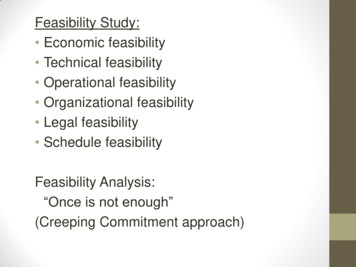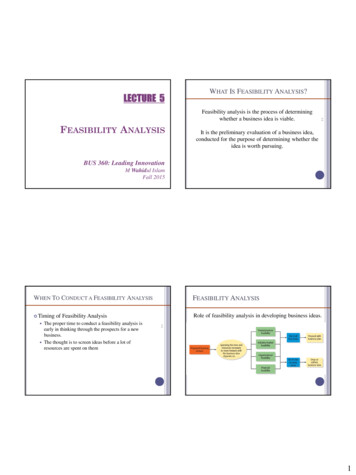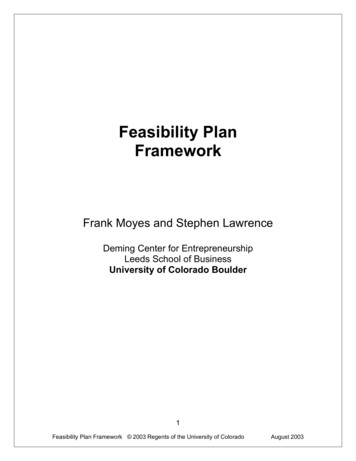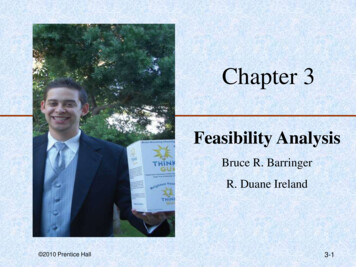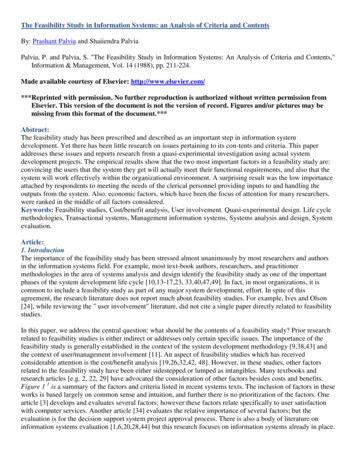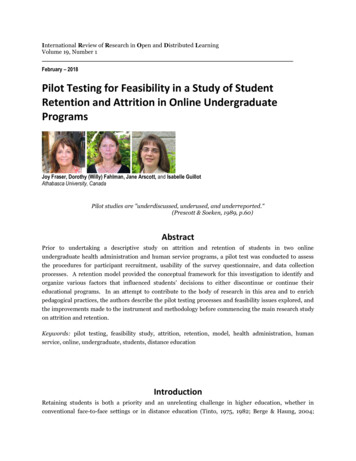
Transcription
International Review of Research in Open and Distributed LearningVolume 19, Number 1February – 2018Pilot Testing for Feasibility in a Study of StudentRetention and Attrition in Online UndergraduateProgramsJoy Fraser, Dorothy (Willy) Fahlman, Jane Arscott, and Isabelle GuillotAthabasca University, CanadaPilot studies are "underdiscussed, underused, and underreported."(Prescott & Soeken, 1989, p.60)AbstractPrior to undertaking a descriptive study on attrition and retention of students in two onlineundergraduate health administration and human service programs, a pilot test was conducted to assessthe procedures for participant recruitment, usability of the survey questionnaire, and data collectionprocesses. A retention model provided the conceptual framework for this investigation to identify andorganize various factors that influenced students’ decisions to either discontinue or continue theireducational programs. In an attempt to contribute to the body of research in this area and to enrichpedagogical practices, the authors describe the pilot testing processes and feasibility issues explored, andthe improvements made to the instrument and methodology before commencing the main research studyon attrition and retention.Keywords: pilot testing, feasibility study, attrition, retention, model, health administration, humanservice, online, undergraduate, students, distance educationIntroductionRetaining students is both a priority and an unrelenting challenge in higher education, whether inconventional face-to-face settings or in distance education (Tinto, 1975, 1982; Berge & Haung, 2004;
Pilot Testing for Feasibility in a Study of Student Retention and Attrition in Online Undergraduate ProgramsFraser, Fahlman, Arscott, and GuillotHeyman, 2010; Rintala, Andersson, & Kairamo 2011). Tinto’s (1982) analyses of undergraduate degreecompletion rates from 1880-1980 prompted him to say “rates of dropout from higher education haveremained strikingly constant over the past 100 years” (p. 694). He observed that students were droppingout at a rate of 45% with little variation over time. More than three decades after Tinto’s study, theproblem of retention persists in higher education generally, and is an even greater concern in distance anddistributed learning contexts.Indeed, attrition and retention became the focus of concern for aninvestigation in the Bachelor of Health Administration (HADM) and Human Service (HSRV) programsdelivered online at a single open and online university.As a precursor to the main descriptive study on attrition and retention, a pilot study was conducted todetermine the feasibility of using a survey questionnaire and the recruitment and data collectionprocesses. The online survey instrument was structured around a retention model that the researchershad not previously employed. It was believed that the model would provide an effective framework fororganizing the factors contributing to students’ decisions to either discontinue or continue their onlinestudies.Historically, pilot and feasibility studies were not usually reported, and nor were they topics of muchdiscussion in the research literature. While to some extent this continues to be the case in educationalresearch, pilot and feasibility studies have recently become the focus of extensive debate in the healthrelated literature. It would be beneficial if similar attention were given to pilot and feasibility studies inthe broader research context, including the education community. In an attempt to contribute to the bodyof research in this area, the authors describe the pilot testing process, the specific feasibility issuesexplored, and modifications made to prepare for the main study on attrition and retention in distanceeducation. First, some background information is provided, including a definition of terms; followed by adiscussion of the purpose, differences, and similarities of pilot and feasibility studies described in theliterature. The definitions and purposes proposed in the health research are relevant to and help informeducational research, and are therefore included in the background discussion in this paper.Background on Pilot and Feasibility StudiesDefinition of TermsIn general, a pilot precedes and is closely related to a larger study (Prescott & Soeken, 1989; Lancaster,Dodd, & Williamson, 2004; Eldridge et al., 2016). A pilot is often viewed synonymously with a “feasibilitystudy intended to guide the planning of a large scale investigation” (Thabane et al., 2010, p. 1). In effect,pilots comprise a risk mitigation strategy to reduce the chance of failure in a larger project.The word pilot has several different meanings in the research literature; however, as Eldridge et al. (2016)point out, definitions of pilot studies usually focus on an experiment, project, or development undertakenin advance of a future wider experiment, project, or development. In other words, a pilot study facilitatesdecision-making, and therefore serves as “a small-scale experiment or set of observations undertaken todecide how and whether to launch a full-scale project” (Collins English Dictionary, 2014, para 1).261
Pilot Testing for Feasibility in a Study of Student Retention and Attrition in Online Undergraduate ProgramsFraser, Fahlman, Arscott, and GuillotAn informal term often used for feasibility is doability; Eldridge et al. (2016) observed that outside of thehealth context, definitions of feasibility and feasibility studies focus on the likelihood of being able to dosomething easily or conveniently, and on the “assessment of the practicality of a proposed plan ormethod” (para. 16). Moore, Carter, Nietert, and Stewart (2011) noted that pilot studies imply feasibility tothe extent that they are “preparatory studies designed to test the performance characteristics andcapabilities of study designs, measures, procedures, recruitment criteria, and operational strategies thatare under consideration for use in a subsequent, often larger, study” (p. 332).There is no clear distinction between pilots, pilot trials, and feasibility studies in the way the terms areused (Thabane et al. 2010). van Teijlingen and Hundley (2002) argued that “[t]he term 'pilot studies'refers to mini versions of a full-scale study (also called 'feasibility' studies), as well as the specific pretesting of a particular research instrument such as a questionnaire or interview schedule” (p. 1). Bowen etal. (2009) similarly used the term feasibility study “to encompass any sort of study that can helpinvestigators prepare for full-scale research leading to intervention” (p. 453).Arain, Campbell, Cooper, and Lancaster (2010) do not agree that the terms pilot and feasibility can beused interchangeably; these authors contend that a feasibility study is undertaken to determine importantcomponents critical to the development of the main study, whereas a pilot study is the conduct of themain study in miniature. This aligns with others who suggest that due to the specific goals of each, pilotand feasibility studies are mutually exclusive. For example, Bugge et al. (2013) noted that feasibilitystudies are designed to “ask questions about whether the study can be done” and they agreed that pilottrials are “a miniature version of the main trial, which aim to test aspects of study design and processesfor the implementation of a larger main trial in the future” (p. 2).The numerous, and conflicting definitions and interpretations; differences in current usage, and diverseopinions in the health research community regarding the concepts of pilot and feasibility; motivatedEldridge et al. (2016) to undertake extensive work to clarify the issue. They concluded that rather thanviewing pilot and feasibility studies as separate entities, pilot studies are best defined as subsets offeasibility studies; therefore, feasibility is conceptualized as “an overarching concept for studies assessingwhether a future study, project or development can be done” (para. 23). This means that all studiesaiming to assess “whether a future [randomized control trial] RCT is doable [are defined] as ‘feasibilitystudies’" (Eldridge et al., 2016, para. 30). Hence, a systematic review or meta-analysis of the researchliterature could be classified as a feasibility study, but not as a pilot study. Moreover, these authorsdetermined that although “all pilot studies are feasibility studies not all feasibility studies are pilotstudies” (Eldridge et al., 2016, para. 17).Eldridge’s team (2016) propose that even though a pilot study could ask the same questions as a feasibilitystudy, a pilot has specific design features. Consequently, they noted that:While piloting is also concerned with whether something can be done and whether and how weshould proceed with it, it has a further dimension; piloting is implementing something, or part ofsomething, in a way you intend to do it in future to see whether it can be done in practice (para.17).262
Pilot Testing for Feasibility in a Study of Student Retention and Attrition in Online Undergraduate ProgramsFraser, Fahlman, Arscott, and GuillotPurpose of Pilot and Feasibility StudiesPilot studies. In research textbooks from the 1980s, the purported purpose of pilot studies wasgenerally only to test, on a small scale, the steps outlined in a previously-developed research plan, andthen based on the results of the pilot, revisions would subsequently be made to the plan (Ackerman, &Lohnes, 1981; Brink & Wood, 1983; Burns & Grove, 1987; Lieswiadomy, 1987; Polit & Hungler, 1987). Ithas been suggested that many researchers had misconceptions that pilot studies required too much timeand energy for the research team to bother with them, given their narrow range of purposes (Prescott &Soeken, 1989; Hinds & Gattuso, 1991). But as Cope (2015) observed, while a pilot or feasibility study couldbe seen as “a burden or an added step in conducting a large-scale study,” researchers can realize benefitsfrom these investigations that “outweigh the added effort and increase the likelihood of success” (p.196)even if there is no guarantee that they will avoid all problematic issues for the main study. Pilot studyresults can help identify actual and potential problems that researchers can address before beginning theanticipated future study. It has long been recognized that when used this way, “pilot work serves to guidethe development of a research plan instead of being a test of the already-developed plan” (Prescott &Soeken, 1989, p. 60).Researchers have come to understand that not only can pilots help answer methodological questions thatcould guide the researcher toward “empirically determined non-arbitrary answers to design issues” thatneed to be addressed (Prescott & Soeken, 1989, p. 60), pilot studies can serve other important purposes(Doody & Doody, 2015). An investigator might undertake a pilot in order to evaluate the execution of themethods and feasibility of recruitment, randomization, retention, measurement, and assessmentprocedures; the implementation of new procedures and interventions (Leon, Davis, & Kraemer, 2011);refining new and existing tools (Polit & Beck, 2004), or widening or narrowing eligibility criteria for therecruitment of participants (Conn, Algase, Rawl, Zerwic, & Wyman 2010). For instance, Chu (2013)conducted a pilot study on teacher efficacy to evaluate the clarity of the items to be used in the formalstudy in order to ensure that measurement instruments were reliable and valid in the educational contextbefore undertaking the formal study.A pilot study is often performed to test the feasibility of techniques, methods, questionnaires, andinterviews and how they function together in a particular context; it can also reveal ethical and practicalissues that could hamper the main study (Doody & Doody, 2015). Therefore, pilot studies help researchersidentify design flaws, refine data collection and analysis plans; gain experience with and train the researchteam; assess recruitment processes; and learn important information about participant burden prior toundertaking the larger study (Prescott & Soeken, 1989; Beebe, 2007). If participants experience difficultyin completing survey instruments, this may prompt researchers to modify item wording, change the orderin which questions are presented, or alter the instrument format (Conn et al., 2010). There is strongsupport in the literature that pilot studies should be undertaken to identify and mitigate risks associatedwith future study design, sample size, sample selection, data collection, data management, and dataanalysis (Jairath, Hogerney, & Parsons, 2000; Moore et al., 2011).Feasibility studies. Feasibility studies evaluate individual critical components necessary for thelarge-scale study, such as participant recruitment, ability to execute the intervention, and accuracy of theintervention protocol (Arain et al., 2010; Tickle-Degnen, 2013). Conducting a feasibility study can be seen263
Pilot Testing for Feasibility in a Study of Student Retention and Attrition in Online Undergraduate ProgramsFraser, Fahlman, Arscott, and Guillotas “a developmental learning process in which the study procedures and intervention can be adapted asnecessary during the study to achieve the most promising outcomes” (Dobkin, 2009, p. 200). Following afeasibility study, the researchers identify strategies to address any challenges, and revise components asnecessary prior to designing a pilot study to evaluate intervention outcomes in a more formal manner.While there seems to be little difference from pilots, feasibility studies tend to focus on the process ofdeveloping and implementing an intervention and result in preliminary examination of participantresponses to the intervention (Gitlin, 2013; Orsmond & Cohn, 2015). Dobkin (2009) highlights that“[b]ecause adaptation is an important feature of feasibility studies, establishing fidelity to demonstratethat the intervention procedures or protocols were implemented as intended most likely occurs in thepilot stage” (p. 200). Pilot studies, on the other hand, “more clearly focus on outcomes, rather thanprocess, and include a more controlled evaluation of participant responses to the intervention” (Orsmond& Cohn, 2015, p. 2).Lee, Whitehead, Jacques, and Julious (2014) agreed that the purpose of pilot trials is “to provide sufficientassurance to enable a larger definitive trial to be undertaken” (p.1), but they disagree with the order offeasibility and pilot studies described above. Instead, they support the notion put forth by Leon, Davis,and Kraemer (2011) that pilot results are meant to inform feasibility and identify modifications needed inthe design of a larger, ensuing hypothesis testing study. They argue that a pilot serves an earlier-phasedevelopmental function that will enhance the probability of success in larger subsequent studies; throughpilot studies investigators are able to assess recruitment rates, usability of instruments, or whether certaintechnologies can be implemented and make indicated changes.Leon et al. (2011), as well as Lee et al. (2014) caution that while a pilot study might be the first stepneeded when exploring new interventions or procedures, or innovative applications of an existing one,pilot studies are not used for hypothesis testing, or for evaluating safety, efficacy, and effectiveness.Therefore, feasibility and pilot studies are not expected to have the large sample sizes that are needed toadequately power statistical null hypothesis testing (Thabane et al., 2010). Moreover, “the outcomes ofmost feasibility and pilot studies should be measured with descriptive statistics, qualitative analysis, andthe compilation of basic data related to administrative and physical infrastructure” (Tickle-Degnen, 2013,p. 171). Lee et al. (2014) observed that “pilot studies are more about learning than confirming: they are notdesigned to formally assess evidence of benefit;” and as such, it is usually more informative to provide anestimate of the range of possible responses (p. 10). Furthermore, Williams (2016) noted “that mostjournals do not expect to see an assessment of the effectiveness of interventions in articles reporting onfeasibility or stand-alone pilot studies” (p. 8).PublicationIn the past, it was unusual to see publications of pilot or feasibility studies; reports were rarely seen of anytesting of the processes, resources, and management of clinical trials (Tickle-Degnen, 2013). Although it isnow much more common for pilot studies in medicine and nursing to be reported in the researchliterature (Thabane et al. 2010; Morin, 2013; Lancaster, 2015), it is less common in other fields and withother types of research, such as pilot studies of action research, or other qualitative methods (vanTeijlingen & Hundley, 2002). Nevertheless, because of the many benefits that could be gained from the264
Pilot Testing for Feasibility in a Study of Student Retention and Attrition in Online Undergraduate ProgramsFraser, Fahlman, Arscott, and Guillotsharing of information gleaned from these studies (Arain et al., 2010; Leon et al., 2011; Morin, 2013),researchers are encouraged to publish the results of pilot and feasibility studies (Eldridge et al., 2016).Publishing is important for a number of reasons, not the least of which is that learning from the results ofother pilot projects could potentially conserve time, energy, and research resources (Hinds & Gattuso,1991; Doody & Doody, 2015; Eldridge et al., 2016). Additionally, the publishing of pilot outcomes in onefield could facilitate collaborative projects with individuals in other areas once they are informed of theresearcher's interests; what is learned in one profession or disciplinary area can be applied to other fields.For example, information from publications in health literature is relevant to and can be applied ineducational research, as is the case with Bowen et al.’s (2009) suggestions from public health researchabout how to decide whether or not to undertake feasibility studies. Sharing key information, includingpitfalls, can prevent unnecessary duplication of efforts and over-expenditure of public resources. Moreimportantly, in research involving humans, it can minimize the impact on human subjects (Connelly,2008; Conn et al., 2010; Wolfe, 2013; Doody & Doody, 2015) and facilitate culturally competent research(Kim, 2011). Therefore, researchers have both scientific and ethical obligations to try to publish the resultsof every research endeavor (Thabane et al., 2010).Not only should investigators be encouraged to report their pilot studies, they should report theimprovements made to the study design and the research process as a result of the pilot (van Teijlingen &Hundley, 2002). In quantitative studies, in addition to feasibility objectives, researchers should indicatehow feasibility was assessed and evaluated and how they dealt with any recruitment issues (Algase, 2009;Thabane et al., 2010; Leon et al., 2011). In qualitative studies, researchers should indicate how theeffectiveness of the data-collection and analysis techniques were evaluated; results should be interpretedwithin the context of viability and when necessary, include what is needed to make the study viable (Arainet al., 2010; Thabane et al., 2010). O’Cathain et al. (2015) noted that reports should include a descriptionof the methods used for both quantitative and qualitative analysis and findings.Application to Distance EducationAlthough many types of feasibility and pilot studies could be applicable to research in distance education,no framework or typology has been developed specifically for research in this field. Beyond the healtharena, (where feasibility studies typically focus on preparing for drug trials in which a single drug orintervention is being tested for specific outcomes), published feasibility and pilot study frameworks areuncommon. In educational research, there is no single factor that might influence the behaviors andoutcomes for students. Rather, a number of interrelated personal, circumstantial, and institutional factors(Berge & Haung, 2004) contribute to the learning and teaching experience and affect student outcomes.Moreover, educational outcomes are often theoretical constructs (preferences related to measures ofstudent satisfactions) rather than direct observables (e.g., remediation of symptoms or a change inmicrobiology or physiology), and they are generally measured along a conceptual continuum (not a truecount such as in tumor size or laboratory tests). Although course examinations and expected outcomesmight be somewhat standardized, educational interventions are meant to be student-centered and highlyindividualized as opposed to highly standardized. Nevertheless, as described above, properly conductedpilot studies can greatly strengthen outcomes of the main study regardless of the field (van Teijlingen &Hundley, 2002; Cohen, Manion, & Morrison, 2007; Gudmundsdottir & Brock-Utne, 2010; Leon et al.,265
Pilot Testing for Feasibility in a Study of Student Retention and Attrition in Online Undergraduate ProgramsFraser, Fahlman, Arscott, and Guillot2011; Doody & Doody, 2015). In the next section, we describe the process and outcomes of a pilot studyconducted prior to the main study on attrition and retention in two undergraduate programs offered bydistance education.Pilot Study on Retention and AttritionFor the purposes of this paper, the definition of pilot study put forth by Doody and Doody (2015) is used,where “a pilot study is a small-scale version of a planned study conducted with a small group ofparticipants similar to those to be recruited later in the larger scale study” (p. 1074). The objective of thepilot study was to increase the probability of success in the main study by testing the feasibility of theprocedures for recruitment and retention of participants, testing for content validity and face validity ofthe questions, and assessing the usability (including ease of access and navigation) of the technologyemployed for administering the questionnaire.MethodsConceptual FrameworkBerge and Huang’s (2004) conceptual framework (Figure 1) was selected for its usefulness in organizingthe data and study outcomes. In this framework, the variables identified as affecting student retention areclustered into three main categories: personal, institutional, and circumstantial (Table 1). “[B]othstudents and institutions can identify specific variables in these three functional groups when makingdecisions to persist or when developing programs leading to persistence that is highly contextual tostudent, institution and event” (Snow, 2016, p. 2).266
Pilot Testing for Feasibility in a Study of Student Retention and Attrition in Online Undergraduate ProgramsFraser, Fahlman, Arscott, and GuillotFigure 1. Sustainable retention model including e-learning. From “A model for sustainable studentretention: A holistic perspective on the student dropout problem with special attention to e-learning,” byZ. L. Berge and Y. P. Huang, 2004, DEOSNEWS, 13(5), p. 16. Reprinted with permission.Table 1Range of Variables Affecting isticsIndividual Identified VariablesAgeEthnicity/raceGenderParental educational levelParental expectationsAcademic skills and abilitiesLearning strategiesMotivationPrior educational experiencesSelf-efficacy for learning and performanceTask valueInstitutional attitudes:BeliefsValues267
Pilot Testing for Feasibility in a Study of Student Retention and Attrition in Online Undergraduate ProgramsFraser, Fahlman, Arscott, and GuillotCircumstantialAcademic and socialcharacteristicsDegree of congruence between the needs ofindividual students and the philosophicalleanings of the institutionLearner supportNormative systems processStructural processesInstitutionalinteractionsSocial interactions with studentsAcademic interactionsCourse design and facilitationExternal interactionsStudent’s:Family circumstancesResponsibilities and perceived stressThe learner’s lifeLevels of satisfactionWorkRandolph and Crawford (2013) posited that “studies such as Frankola (2001), Muilenberg and Berge(2005), and Young and Bruce (2011) have helped validate Berge and Huang’s (2004) three-part theory”(p. 54), while Snow (2016) observed that although it “appears to provide a holistic approach to studentretention, this model has neither been widely tested nor reviewed in academic circles” (p. 2). Hence, ourdecision to further test the model in the distance education context was based on a number of factors.First, it has been tested elsewhere, and found to be a useful model in the context of distance education(Tyler-Smith, 2006). Second, it is recognized as a model that is flexible, “context specific” and “allowsadopters to address variables as they are deemed relevant” (Berge & Huang, 2004, para. 22), and can beadapted to particular settings in ways that best enable researchers to examine which factors facilitateretention or contribute to attrition. For example, from an institutional perspective, researchers canidentify areas where institutional support could affect retention rates such as “curriculum and instruction,academic and social supports, and institutional management” (Berge & Huang, 2004, para. 29).ParticipantsThe researchers of this pilot study shared the view that in any discussion of learner attrition, one needs toconsider the factors that learners themselves cite as reasons for dropping out or not completing. Thelearner’s perception of what constitutes a barrier to continuation or a factor contributing todiscontinuation or continuation, provides valuable insights in designing and implementing distancecourses, continuing or improving the processes, support mechanisms, and strategies that can enhanceretention. Therefore, our goal was to gain the perspective of those who discontinued their studies andthose who graduated from the Health Administration (HADM) & Human Services (HSRV) programs at asingle open and online university.268
Pilot Testing for Feasibility in a Study of Student Retention and Attrition in Online Undergraduate ProgramsFraser, Fahlman, Arscott, and GuillotThe Office of the Registrar provided the student non-completion and graduate data from January 1, 2010to December 31, 2014. It was originally anticipated that the pilot testing would include a sample of up to10 students; however, members of the Ethics Review Board questioned whether there would be anadequate response rate from students who had left the two programs, especially those who left a numberof years prior to the study. Therefore, the pilot sample was expanded to enable more thorough testing ofthe response rate, the feasibility of achieving a viable sample for the pilot testing of the survey instrument,and the research processes planned for the main study.To test our assumption that past students would respond regardless of when they left the programs, allstudents from the two programs were included if they met the completion and attrition criteria for theentire year (January 1 to December 31, 2010), which was five years prior to the study. Participants whomet the university completion criteria were all those who graduated in 2010. Those who met theenrolment and withdrawal criteria for the Health Administration and Human Service programs includedthose who: 1) were enrolled in the program and had registered in at least one course on or after January 1,2010; and 2) had been inactive in a course for any 12-month period up to December 31, 2010. (Theparticipants for the main study met the same criteria for the period January 1, 2011 to December 31,2014.) Table 2 shows the composition of the 2010 sample for the pilot study.Table 2HADM and HSRV Graduates and Withdrawals January 1 to December 31, 2010ProgramHADMHSRVTotalGraduates number (%)4 (9%)26 (33%)30 (25%)Discontinued number (%)39 (91%)52 (67%)91 (75%)Total number (%)43 (36%)78 (64%)121 (100%)InstrumentA comparative online survey design was employed to gain the perspectives of students from two differentundergraduate programs to better understand what factors contributed to the completion of their studiesor prompted their leaving prior to completion of their degree. As no validated questionnaires relevant tothe conceptual framework were found in the review of the literature, adaptations were made to the“leaver” survey questionnaire used by the university to follow-up with students who discontinued theirstudies. As reported by the university’s Department of Institutional Studies, the questions had been testedfor validity and reliability; nevertheless, the pilot allowed for field-testing of this questionnaire for contentand face validity in order to obtain feedback on the following: clarity, errors, readability, impartiality, appropriateness of the type and format of questions; and time required to complete the questionnaire.Most of the pilot survey questions were in Likert-scale format, with a space for open-ended questionswhere participants could share their reflections and feelings about the courses, programs, interactionswith the university, circumstances facilitating their continuing or leaving, and their thoughts about269
Pilot Testing for Feasibility in a Study of Student Retention and Attrition in Online Undergraduate ProgramsFraser, Fahlman, Arscott, and Guillotreturning to this university, either to complete their undergraduate program or to enroll in graduatestudies. The questionnaire also included questions on demographic data related to student personalprofiles: place of residence (rural or urban), gender, age, marital status, dependents, previous experiencewith distance education, and institutional data: program information, the length of time as a student,reasons for leaving, factors that facilitated continuing on to graduatio
The word pilot has several different meanings in the research literature; however, as Eldridge et al. (2016) point out, definitions of pilot studies usually focus on an experiment, project, or development undertaken in advance of a future wider experiment, project, or development. I
